It’s 03:30 on a muggy January morning in Port Elizabeth. Bleary eyed and with the coordination of a drunken marionette, I attempt to stop the first strains of Rodriguez’s “Crucify your Mind” cheerfully emanating from my buzzing phone, which does not seem to appreciate the desperation in my voice while I argue with it to please shhhhh… just a few more minutes! Not being able to find the right combination of buttons, I admit defeat and wobble off to the shower for the morning’s next challenge… shower mixer mechanics in an unfamiliar bathroom. Feeling only slightly refreshed and dryly thinking that I deserve some sort of Survivor Immunity Idol for managing to neither scald nor freeze myself, I remember why I am up at this ungodly hour… my first trip to Lesotho. For years a Varsity buddy, Michael, has been regaling us with stories from the Mountain Kingdom and insisting that we should come along and experience it for ourselves so when he extended an invite late last year I didn’t hesitate to accept. Well I did hesitate, a little, until he assured me that there was a flushing toilet and once that was established, there was nothing stopping me!
And so, with the car impressively packed Tetris-style, we head off to meet and pick up the rest of our travel crew. Therese and her seven year old, blanket-clad twin granddaughters, Keziah and Keren, bundle into the car. While Therese has been travelling to Lesotho for years, it is the twins first time making the trip and the excitement, although slightly tempered by sleepiness, is apparent. As we leave Port Elizabeth, flamingos (Phoenicopterus roseus) silhouetted against the deep, rich red orb rising over the Indian Ocean, we are suddenly plunged into a thick mist giving the sensation of travelling in a bubble down the freeway towards Grahamstown. We settle on Michael’s retro playlist to accompany us to the border, my eclectic mix not cracking the nod… maybe later. Through the mist we catch glimpses of the scenery rushing past, towering cliffs standing like silent giants frame sections of the route, and when breaking through the clouds while summiting a pass we are afforded the view of a deep valley shrouded in swirling mist. By 08:00 this mist has lost the battle with the unforgiving African sun, dissipating to reveal a myriad of vistas. From arid landscapes dotted with prickly pears (Opuntia spp.) to pine plantations hugging the rolling slopes; from plateaus of scrubland to valleys of thicket; from the lush greens of cultivated lands to the wide, open spaces punctuated only by the Karoo’s iconic windmills and from landscapes dominated by proud-standing euphorbia and towering termite mounds to an oasis fringing a river’s banks. The continual transitioning of the vegetation types is astounding; a twist in the roadside suddenly exposes a burst of purple flowers stark against the backdrop of brittle, brown grass while around the corner weeping willows could be found lazily dipping their leaf-laden branches into the cool waters of an idly flowing river. We spot vervet monkey (Chlorocebus pygerythrus) sentries perched atop fence posts while the rest of the troop forage in the shade of the flowering Acacia trees; free-ranging cattle, horses, sheep and goats are also often encountered casually wandering into the road and brazenly staring down any car with the audacity to think that its grass-finding mission was any less important than the occupants’ own destination.
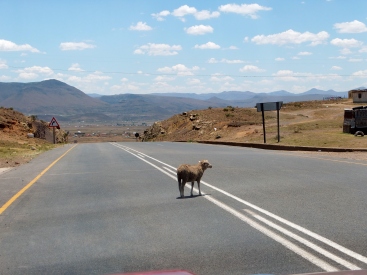
One of the many brazen animals encountered along the roads.
As the sun continues to beat down on the hot, dry earth; cattle begin to crowd around the lonely Acacia trees sporadically dotted across the landscape… I can feel the effect of the mercury slowly but steadily creeping up the thermometer. I gaze out the window trying to ignore the stifling heat, rather marvelling at the continually transforming landscape and how it is a fitting tribute to the diversity found throughout South Africa. The majestic, jagged peaks of the Amathole Mountain Range harshly rising out of the gentle surrounding countryside is truly breath-taking; the light striking them from the east casting dark shadows across the rock-face had me wondering what it would have been like for the 1820 Settlers to view them for the very first time. As we drive over the Esk River, I am struck by the stark contrast of crossing the River Esk in Dumfries and Galloway; the severe but striking African landscape contrasting so completely with the gently rolling, evergreen hills of the Scottish Lowlands. The Scottish heritage of the area is easily apparent in the names of the surrounding towns of Elliot, Ugie and Maclear and the beautiful stone bridges just outside both Ugie and Maclear. Upon further research, I discover that these two almost identical bridges were built in 1898 and 1899 respectively and to my utter astonishment the bridge in Maclear is called the Sivewright Bridge! We even walk along it; under the shade of the weeping willows, sipping Steri Stumpies and don’t even realise the awesome history beneath our feet!
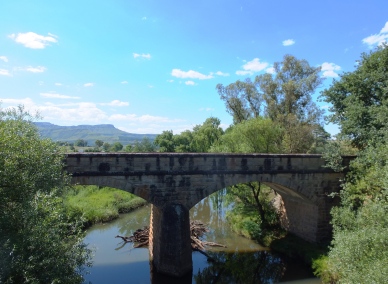
The Scottish bridge just outside the town of Ugie in the Eastern Cape.
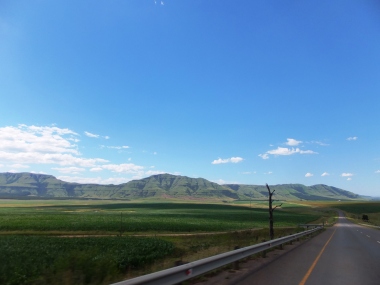
Breathtaking mountain vistas.
“Pata Pata” by Miriam Makeba and Toto’s “Africa” (however cliché) become the soundtrack to our journey as we head further into the hinterland of the Eastern Cape. The diverse bird-life observed throughout the trip has me enthusiastically insisting that Michael just has to stop the car for me to take a photograph or five. The first sighting that has me bouncing animatedly in the front seat is a small aggregation of grey crowned cranes (Balearica regulorum) and white storks (Ciconia ciconia) foraging in the fields of cultivated land found fanning off from the roadside. This is turning into a series of firsts for me as these birds are two of a number of species spotted during our trip that I have never seen before. Stopping at a picnic site for a snack and switching off the car, we are suddenly absorbed by the deafening song of the cicada and the cry of the African fish-eagle (Haliaeetus vocifer) reverberating over the waters of Waterdown Dam. I stand for a moment in the dappled shade of an Acacia tree and just absorb my surroundings, the peacefulness and serenity calming my soul.

Just taking a moment to breathe…

Waterdown Dam.
Just outside of Queenstown our merry little journey comes to an abrupt halt when we suffer a blowout and Michael has to change the tyre in 39 ̊C, this before 12:00. We spend the next hour or so traipsing around town in search of a spare, not wanting to attempt the rugged roads of Lesotho without one. After much questioning of the locals and coming to the realisation that small towns are shut on a Sunday, we manage to track down Terence from Hi-Q who opens up his shop and sorts us out. Taking the Livingstone Road out of Queenstown, we head to Dordrecht, the sun reflecting off the shimmering tin roofs in the distance. The fact that the aircon is broken and hot air is being channelled from the engine and into the car is beginning to take its toll so ingeniously Michael secures bags of ice in front of the air vents in an attempt to cool the air entering the car. Needless to say, one bag ends up on my head while the cubes in the other are enthusiastically consumed by the others… little do we know that this will be the last time for days that we will encounter ice.

Things get interesting!
At 17:40 we say good-bye to tar and hit the gravel roads (apparent in the dreadful squiggles that will now have to pass as handwriting) that serve much of rural South Africa. The hot wind has dropped, the silence disrupted only by the soft clanging of sheep bells echoing off distant valley walls as the animals follow ancient trails crisscrossing the hills. We start climbing the pass to the Ramatsiliso boarder post and are horrified to find that the once fun and challenging route has been graded and covered with concrete; eliciting such comments as, “how boring”, “totally ruined” and “no more fun”. We are therefore at the gate in no time and find it surrounded by goats making themselves at home on the stone outcrops of a crumbling building. The crossing from South Africa to Lesotho is really low-key and over without much fuss. The consistent green mountains and deep valleys of Lesotho glaringly conflict with the diverse landscape present at lower altitudes, very few trees are seen at these elevations. We stop to watch the sun set behind purple mountains in the distance and then make our way towards the house in the spreading darkness, the cool air a welcome feeling on our sunburnt skin. When we eventually reach the house, situated at roughly 2300 m in Ha Semenyane at the foot of the Matebeng Pass, we are warmly welcomed by the family of Anna and Phillip, who own the land on which the house stands. With just enough energy for tea, we all head to bed. I am pleasantly surprised by how light it is after dark, the night sky ablaze with stars, and the temperature a crisp 8 ̊C, I sleep like the dead. I have been warned of the psychedelic dreams that run amok while you sleep in the valleys and on the peaks of the Drakensberg; whether it is the altitude or the clean air it remains a mystery. Whatever it is, the nights are punctuated by complicated arguments coming from the snoozing twins and the odd shriek as one falls out of bed.
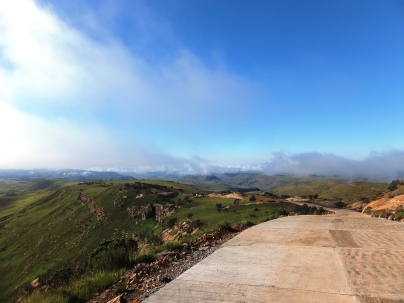
Newly paved pass up to the Ramatsiliso Border Post.
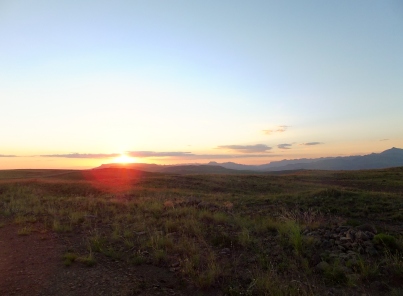
My first Lesotho sunset!

Map of Lesotho – Ezilon Maps
After breakfast, we take a leisurely stroll along the Leqooa River to where it joins the Tsoelikana River from Sehlabathebe, exploring the rock pools and banks for all manner of creepy crawlies, the low water levels evidence of the drought hampering the country. I marvel at the geological aspect of the landscape in the region, happily clicking away as photo opportunities seem to be setting themselves up in every direction. Striding along, amused by the Basotho ponies dotting the hillsides; the altitude suddenly hits me and not only does it feel like an overweight elephant is jumping up and down on my chest, my fingers and feet swell up resembling waterlogged sausages while the dizziness leaves my world spinning. Only the cool waters of the mountain streams seem to counter these peculiar effects, which last for a couple of days.

Morning walk to the river.

Traditional Basotho home.

Towering mountains make great dramatic backdrops.

Basotho Pony.

The meeting of the Leqooa and Tsoelikana Rivers.

Hitching a ride.
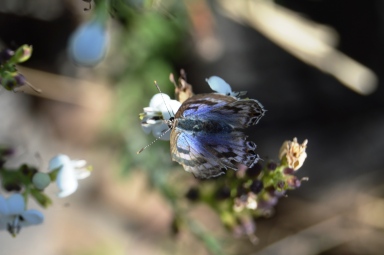
Distractions along the river banks.
A drive up the Matebeng Pass to approximately 3000 m is how we spend the afternoon, stopping halfway for lunch. The sweet smell of fynbos on the lower slopes, the herdsmen shepherding their flocks along the precarious contours, a pair of soaring Cape vultures (Gyps coprotheres) high above the summit, lizard spotting and many urgent stops for bird photographs keep me occupied and distracted from some of the corners with their more vertical drops. We even meet a couple of German travel writers stretching their legs at the top of the pass and while Therese chats to them about their many adventures, an enthusiastic game of “I-Spy” breaks out between me, Michael and the girls. Some questionable tactics being employed. On the way back down the Matebeng, clouds begin to cast dark shadows that seem to morph into mystical creatures sailing across the mountain slopes and we go in search of a suitable swimming spot. After much enjoyment swimming in the waters of the Leqooa, warmed by the dark rocks forming the pools, we head back down to the village. In the evening after supper, Anna introduces me to Papa and Moroho, a delicious Basotho staple of maize meal and wild spinach heavily salted and sautéed with onion and peppers. I learn that while Anna runs the local shop, her husband Phillip owns four others in different villages across the area while also being a sheep and cattle farmer and owning a brick-making business; all of which keep him on the road all day commuting between them.
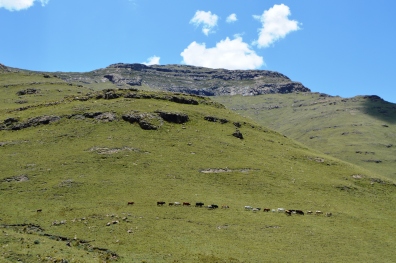
Herds of cattle graze on the slopes of the Matebeng.

Tough Lesotho calf.

Matebeng Pass.
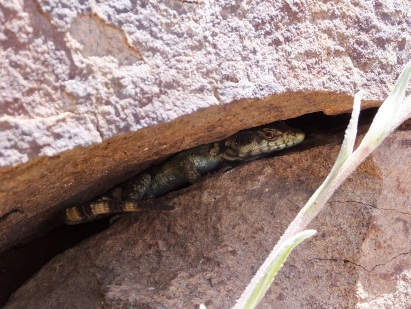
Seeking shade.

Mountain pipit (Anthus hoeschi).

Our 4X4 chariot.
I quickly realise that using the toilet requires a smidge more planning than usual; involving a complicated series of water transfers between the outside tap and a range of buckets, varying in size, to manually fill the cistern preventing you from leaving things to the last minute. Rather than heating kettles on the gas stove in the morning I opted for a cold but refreshing bath in a tub on the bathroom floor, my attitude I’m sure would be quite different if this had all occurred during winter. Being without electricity has never really bothered me (the South African Load-Shedding regime training me well) so I relish the time spent in a land away from alarms, apps, icons, notifications and monotonous TV. While solar chargers are available, I have taken the opportunity to switch off and rather immerse myself in my surroundings, waking up as the darkness gives way to the smudged light of dawn and going to sleep when the yawning begins to seriously impede my speech. One aspect of Lesotho life that becomes abundantly clear is that the passing Kobo-clad (traditional cloak/blanket) herdsmen and villagers are incredibly friendly, forever greeting you with Khotso, a customary greeting of a raised hand, meaning “Peace” while wearing the iconic Mokorotlo (conical Basotho hat made from woven straw and modelled on the cone-shaped Qiloane Mountain located in the Maseru District of the country).

Herdsman heading off up the Matebeng after his herd.

Room with a view.

Looking forward to some rain!
The highlight of day two for me is spotting a rare bearded vulture (Gypaetus barbatus) soaring high above the destination of today’s exploratory excursion, the Belebesi Cave. This bird, while appearing to be an avian caricature of Pai Mei from the Kill Bill franchise, is not quite as haunting as some of the more widespread vulture species but utterly exquisite. An isolated population inhabits the mountainous topography of Lesotho and the rest of the Drakensberg range in South Africa but with a decreasing population trend and a range that has sadly contracted during the last century, it has been given the IUCN classification of Near Threatened. There are thought to be only 400 individuals left in the wilds of Lesotho and South Africa (The Lesotho Review 2015). There are many legends throughout history that surround this impressive bird, one of which being found in Iranian mythology that considers the rare bearded vulture the symbol of luck and happiness. It was believed that if the shadow of one of these birds fell on you, you would rise to sovereignty (Pollard 1947)… I wait with bated breath! The echoing cave is truly awesome and home to an ancient Basotho herdsman’s drystacked stone shelter and animal enclosure, the blacked ceiling of the cave evidence of the years of fires used to keep warm during the bitterly cold winters experienced in these mountains. Fresh water seeps in along the back walls of the cave allowing the growth of moss and fern.
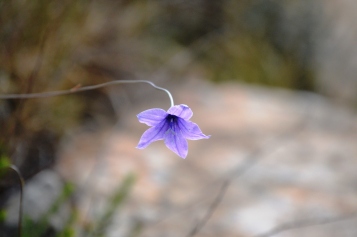
Nodding in the wind.
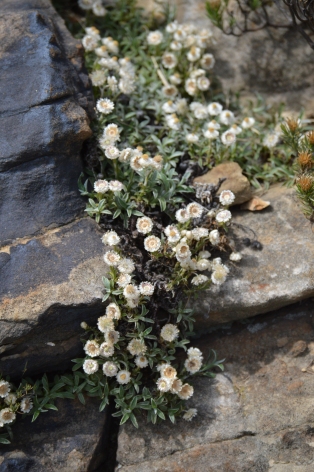
Life will find a way!

The rare bearded vulture (Gypaetus barbatus).

This scenery never gets old!
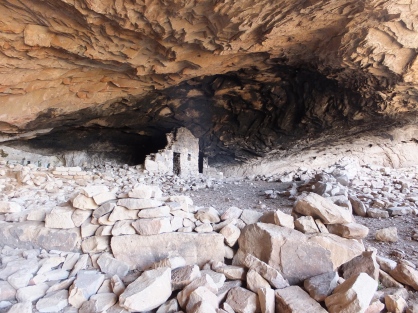
Traditional Basotho drystack dwelling. The smoke from past fires blackening the cave ceiling.
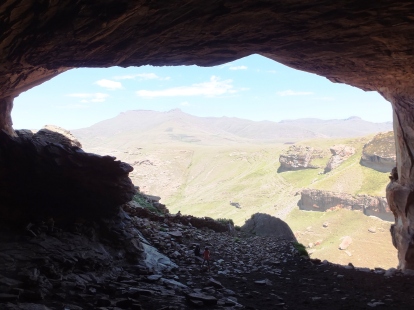
The view from inside the cave.
A relaxing afternoon is spent reading and listening to the lyrics of the song of the trip, “Let’s go fly a kite” from Mary Poppins, being playfully butchered. Lo and behold a kite is unearthed in the storeroom, dusted off and attached to some fishing line for a kite-flying mission up the road. The wind suddenly stopping doesn’t kill the enthusiasm, Keren runs off down the road and into the distance with the kite and the words from their new favourite song floating after them. The evening is spent curled up in a hammock chair on the stoep (quickly becoming my favourite spot from which to observe the changing colours of the mountains and the hustle and bustle of the herdsmen shepherding their herds), with a cup of hot tea watching the cattle being herded off the Matebeng and into the Range Management Centre across the road for dipping and vaccinations. We watch an approaching storm brewing over the western ridges, the wind swirling and the clouds seeming to blow in from three different directions.
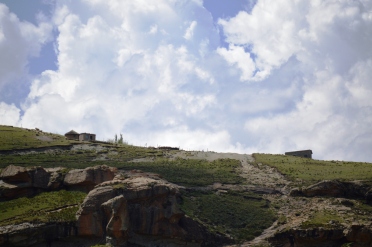
Gathering clouds above Ha Edward.

Approaching storm.

Let’s go fly a kite!
Sehlabathebe (“plateau of the shield” in Sesotho) National Park was established on 8 May 1969 and forms part of the larger Maloti-Drakensberg Transfrontier Park, being declared a World Heritage Site in 2013. The song of the day, “Gangnam Style” by Psy, is being enthusiastically accompanied by two voices from the back of the car. At the lodge we meet a lovely couple, Patrick and Joni who are Peace Corps workers from Colorado and now stationed in Mafeteng. After spending two days of hot and frustrating travel in various taxis, they decide to take Therese up on her offer of joining us in our exploration of the park. At roughly 2800 m, we are on the look-out for the twitching ears of a black-backed jackal snoozing in the grass but we see instead a large secretary bird (Sagittarius serpentarius) strutting along the ridge across the valley, oozing attitude in its black pedal-pushers, the big eyes of Sloggett’s ice rat (Otomys sloggetti) are intermittently spotted as it pokes its head out of small holes dug in to the soil walls along the roadside and common quail (Coturnix coturnix) exploding out of the undergrowth only to suddenly drop back out of sight. We park at the lodge where the King summers and head out onto a plateau strewn with beautifully hollowed out rock formations, boulders, caves and wetlands. The low water levels are further impacting the already critically endangered Maloti minnow (Pseudobarbus quathlambae) that we observe launching out of the warm, muddy waters to feed on the low-flying insects that are attracted to the dwindling pools. We quickly creep under the fence and over the border in to Kwa-Zulu Natal to survey the magnificent views of the drop-off, with its deep valleys and colossal peaks. I would love to have been a prehistoric fly on the proverbial wall when the Drakensberg was being upchucked from the depths of the earth!

Everlasting (Helichrysum sp.).
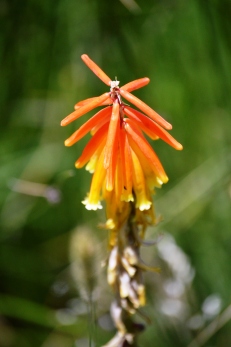
Kniphofia sp.

Grey rhebok (Pelea capreolus).
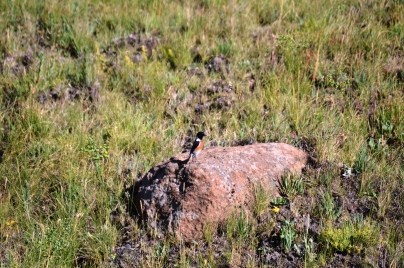
African stonechat (Saxicola torquatus).

The King’s ponies.

Herding the horses.
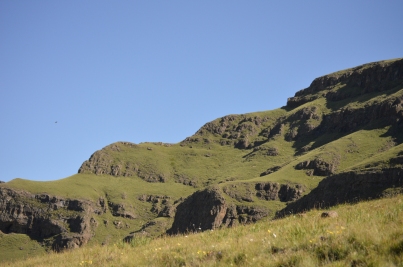
No surprise then that I ran out of battery!
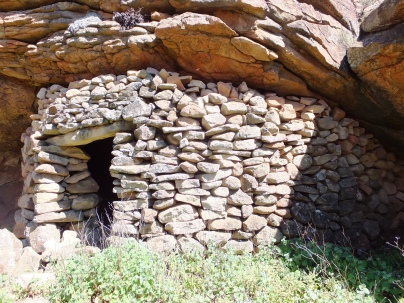
Drystack shelter.

Cave with no roof.
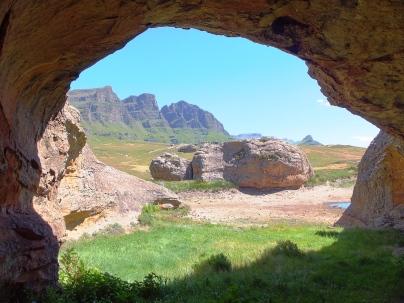
Probably one of the most photographed scenes.

The Devil’s Knuckles.

The guttural flutter of a black-headed heron (Ardea melanocephala).
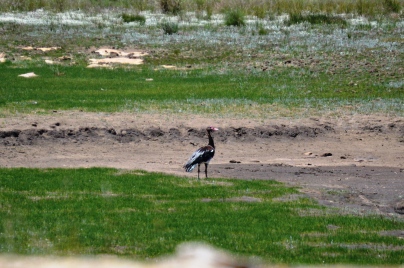
Spur-winged goose (Plectropterus gambensis).

Pair of yellow-billed ducks (Anas undulata).
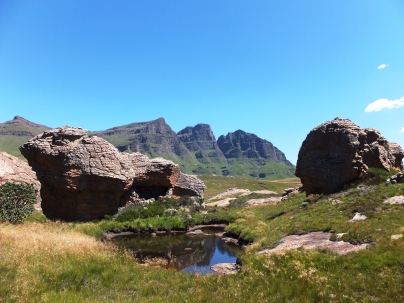
Reflection of the Devil’s Knuckles.

Yet another breathtaking mountain vista!
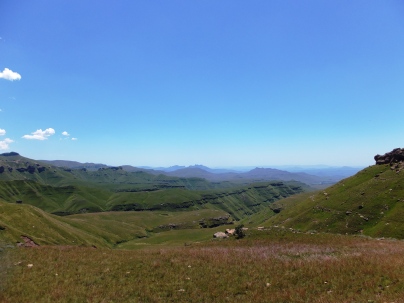
The drop-off into Kwa-Zulu Natal.

Sentinel rock-thrush (Monticola explorator).

Cape longclaw (Macronyx capensis).
On our way back down to the lodge, Michael stops to point out a figure of Mary formed in the rock face high up on one of the buttresses; this is instantly met with “oooohs” and “aaahs” from the back but while I can find dragons in passing clouds, Darth Vader in a fallen boulder and spot a jackal ear in the swaying summer grass I have yet to catch a glimpse of the mysterious figure staring down at us from her precipice. Back at the lodge, I have never been so happy to see refrigerated drinks. The promise of ice makes me giddy while shouts of “brain freeze” explode from all corners of the table. Further down the road, the San Rock Art decorates the walls of the giant formations which are truly beautiful and intriguing, depicting hunters and leaping buck, even a lion appears after much squinting. Many different human forms, colours and etchings begin to emerge, even one shape that is reminiscent of a man heavily wrapped up in winter gear and waiting in the driving rain at a Scottish bus stop. This gets me thinking and I come up with my Devil’s-Advocate thought of the day: At what point does scribbled graffiti on a rock become art? There is nothing more welcoming in Africa than the smell of rain in the distance and the sound of it finally falling. We drive back down the mountain and towards an approaching storm with the windows open, enthusiastically using the windscreen wipers. Joni and Patrick decide to join us back at the house before starting their mammoth trek back to Mafeteng in the morning. It is fascinating listening to the stories of their experiences and refreshing to see the region through the eyes of an overseas traveller.

Because of the heavy mist often shrouding the mountains in the region, flowers can be found in almost every crevice!

A hunter with his leaping buck.
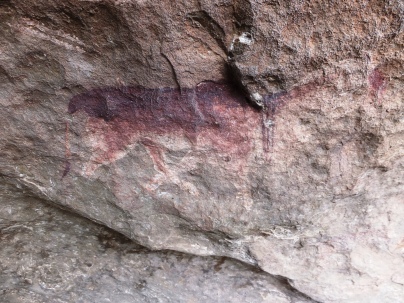
Possible lion.

Such a variety of human forms adorning the walls.

Bundled up Scotsman waiting for the bus.
With the smell of homemade beer brewing in the rondavel next door, we head off to visit Lerato who hails from Jo’berg. She handcrafts beautiful pots from the roadside clay, is a Peace Corps host, grows her own produce, in the past has cooked meals for the kids at the village school and is currently sewing clothes, curtains and bedspreads to order. We sit in her lounge sipping cool drinks while Keren and Keziah are shown how to make pottery animals. We drive up the pass to Ha Edward, a small village on the cliffs overlooking Ha Semenyane, with its summit shrouded in mist it is decidedly eerily up here in the clouds. The lyrics of the girls’ new favourite song, “Tear in my Beer” by Hank Williams, are being heartily belted out by the two little seven year olds and judging by how often they have been asking for it, I reckon they have a new favourite song. Ishmael (Anna and Phillip’s son) joined us for the trip; he attends school in Maseru and is starting Grade: 7 this year. While he is not sure what he would like to do once he graduates from high school, he loves the animals and experiments of science as well as enjoying maths and Sesotho; his favourite animal being a sheep. Descending the pass we encounter the most clapped out old truck (reminding me of Mator from Cars); no windscreen, front wheels bent inwards and doors tied on with fraying rope. It has somehow managed to slide off the side of the pass and is now awaiting help. As a jack is woefully inadequate for the situation, Michael attempts to tow the antique out of its predicament but this is short-lived as he feels it slip. With nothing stopping it from pulling him down the cliff, we leave them to offload and wait for the bigger truck to assist them. Soft rain continues in the afternoon allowing us to fill in a photocopied Fair Lady crossword, play cards, Pictionary and hangman, attempt magic tricks, rehash old jokes and strangely enough attempt to remember all of the ABBA songs. Roasting marshmallows and sipping Amarula by the fire is done with the backdrop of mountains being slowly engulfed by heavy fog and the sound of the fat rain drops falling on the tin roof. The cold chill in the air leaves us all optimistic for snow to greet us in the morning. Reading in bed by headlamp proves dangerous as a giant kamikaze moth spends its time zealously dive-bombing my head.

Love watching how the colours on this mountain change throughout the day.

Kids play “House”.
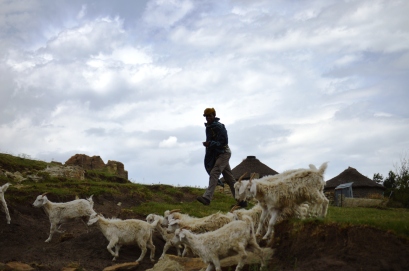
Herdsman and his Angora goats in Ha Edward.

Lone ram looking down on Ha Semenyane.
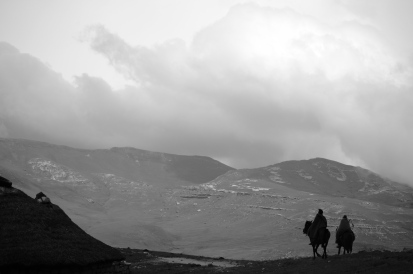
Looks like a scene from a Western!

Lesotho version of Mator from Cars.
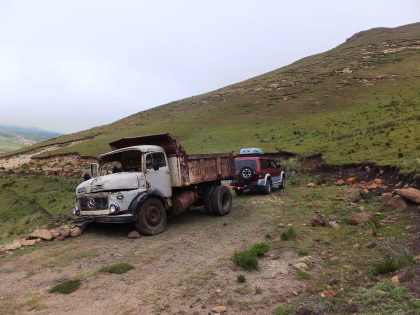
Michael optimistically attempts to pull the truck back on to the road.
The morning is spent lazily swinging in my favourite spot with a cup of hot tea, reading as the sun rises over the mountains dispelling the lingering overnight fog so that only wispy tendrils remain in the shadowed valleys. Music floats over from next door while the kids dance and hula-hoop to the beats and sand is sifted for the bricks being made in the front yard. I decide to take a walk down to and along the river looking for birds and enjoying the tranquil atmosphere as the water gurgles and bubbles over the rocks; male weavers build and proudly display nests while the fastidious females unabashedly tear them down. We do one last walk to the shop and play Snakes and Ladders for the first time since primary school.

Kniphofia sp.

A daisy among thorns.

Common river frog (Amietia angolensis).

Male Cape weaver (Ploceus capensis) awaiting nest inspection.

Having a bite for lunch.

I hear penguins!

On his way home.

The never-ending mist that keeps the temperatures down.
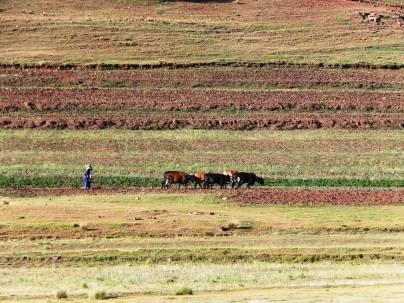
Hand ploughing the fields.
As it is our last morning, we are up early in order to reach the border post at opening time (07:00). I say goodbye to new-found friends with just enough time for a few photos. As we are heading towards the border crossing on the road to Qacha’s Nek, I am soaking up the last of the Lesotho atmosphere, the sun reflecting off the overnight frost transforming the grass into a blanket of blinking crystals. We round a corner at the top of the pass revealing a valley below swathed in cloud and Keziah exclaims, “Look Granny, we’re in Heaven!” and you know what… I reckon she just may be right.
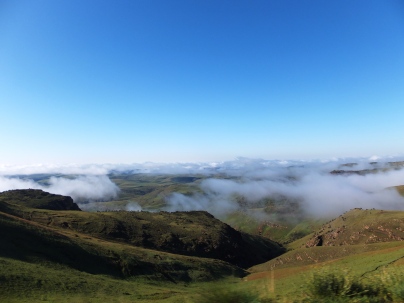
Life above the clouds.
Explore. Dream. Discover.
ACKNOWLEDGEMENTS
I would like to thank my host, Therese, for opening her home up to me and allowing me to experience the magic that is Lesotho… I’m hooked! And to Michael for insisting over the last few years that Lesotho is THE place to visit… thanks for all the missioning! To Keziah and Keren thanks for the endless revamping of popular songs and jokes. Last but not least, to the warm and welcoming people of Ha Semenyane for opening a window into the Lesotho way of life and for allowing me to be a part of it.
REFERENCES
Kopij G. 2002. The Birds of Sehlabathebe National Park, Lesotho. Koedoe 45(1): 65-78.
Pollard JRT. 1947. The Lammergeyer: Comparative Descriptions in Aristotle and Pliny. Greece & Rome 16(46): 23-28.
Nel F. Date unknown. The History of Maclear. [ONLINE] Available at: www.maclear.co.za/MaclearHistory.doc
Sinclair I & Ryan P. 2009. Complete Photographic Field Guide: Birds of Southern Africa. Struik Nature: Cape Town.
The Lesotho Review 2015 – An Overview of the Kingdom of Lesotho’s Economy.



Beautifully written x
LikeLike
Ta Megs ☺️
LikeLike
Wow Sally its as if I was there with you. I really enjoyed.
Can not wait for your next adventure
LikeLike
Thanks Marion! Yup, neither can I 😋
LikeLike
Fantastic Sally – I really love your writing style – makes me want to go experience it !
LikeLike
Thank you! 😊 Well maybe not the heat…that can be done without! 😋
LikeLike
Hello there great explorer… enjoy… do enjoy 😊😊 Sally! I have enjoyed your trip to Lesotho, all the special sights…and the bonus, the people are friendly, makes all the difference when they make you feel welcome. Ta ta for now xx
LikeLike
Thanks Gran… Looking forward to my next adventure 😊
LikeLike
It truly does sound amazing, I am extremely jealous! Thanks for sharing your experience, I see it as my own little trip to Lesotho. 🙂
LikeLike
Hey Celesté, glad you enjoyed it 😊 There will just have to be a next time so that you can experience it too…how about a snowy trip in winter?! 😋
LikeLiked by 1 person